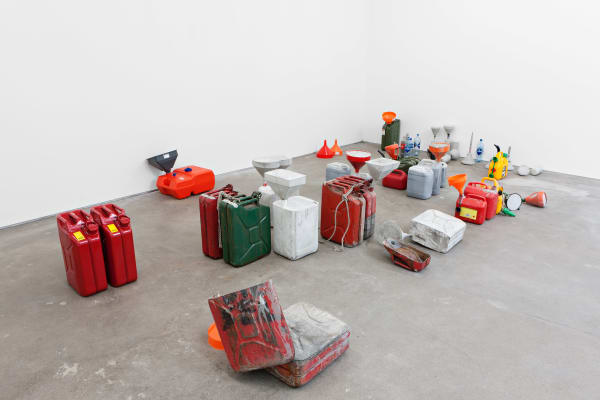MATIAS FALDBAKKEN
STANDARD (OSLO)
PRESS RELEASE
-----
MATIAS FALDBAKKEN
29.08.-27.09.2014 / Preview: Friday 29.08.2014 / 19.00-21.00
------
STANDARD (OSLO) is proud to announce its forthcoming exhibition of new works by Matias Faldbakken. Avoiding the angle offered by a title but recognizably adding to his analysis of half-heartedness as a work method, Faldbakken's exhibition presents eight new sculptures, framed works and works on canvas. Throughout the four exhibition spaces, Faldbakken addresses abstraction as a process of dismantling; a reduction aimed at charging the object with discomfort and / or an equal sense of disappointment.
"If a song can't be written in 20 minutes, it ain't worth writing."
- Hank Williams
"Whatever you write it's always a catastrophe. That's the depressing thing about the fate of a writer… All you deliver is a bad, ridiculous copy of what you had imagined… It's especially hard in the German language, because that language is wooden, clumsy, disgusting. A terrible language that kills anything light and wonderful. The only thing one can do is sublimate that language with a rhythm and give it musicality."
- Thomas Bernhard: "My Prizes" (1980)
So many of the works of Matias Faldbakken are products of the same paradox: while the artist will occasionally offer an impressive investment of physical effort in terms of production, the actual physical objects will almost always offer little certainty in terms of their symbolic significance. The banal is always a possibility, as proven by the segment itself and the question it put forward on the David Letterman Show: "Will it float?". However, this limitation may also be seen to offer some sense of liberation, and in the case of Faldbakken it manifests itself as a pragmatism vice versa product, process and purpose alike. The conclusion may be similar to that of the couple in Joan Didion's "Some Dreamers of the Golden Dream" as they are reaching the last stage before divorce: "a traditional truce, the point at which so many resign themselves to cutting both their losses and their hopes". Not only do the works presented in Faldbakken's exhibition accept such a makeshift set of conditions, but they also appear to be making the "make-do" the pivot point of production.
At the foundation of this production are materials belonging to the category of the lo-cost, easily accessible and equally easily disposable. Faldbakken once again makes use of such items as cardboard boxes, plastic jugs, jerry cans, and garbage and burlap bags as the basis for his sculptures and framed works. These are all objects designed with the intention of serving as vessels - to aid in terms of storing, moving or removing. Naturally they are also objects belonging to the supporting infrastructure of an artistic production. In an act of reversal Faldbakken turns this surplus material of the studio practice into the material of the studio practice. The flattened cardboard box is taken out of circulation, now designated the purpose of a picture plane as well as the point of departure for a discussion regarding the made, the readymade, and - logically also an option - the half-made. Intention and accident so easily come to a 50/50 balance in the works of Faldbakken. Whether what is considered to make the composition of the work are conscious acts or mere residue that came with the raw material (or the transport of it to the artist's studio) is irrelevant. As a result, stickers, stains and scuff marks are the only variations to the framed industrially standardized cardboard boxes with the work whose title is equally prosaically confirming "Four Flat Boxes". While in the case of "Untitled (Burlap & Plastic)" the geometric outlines made in white felt pen on uniform blue garbage bags, are merely tracing of objects put flat against the surface. These are two modes of mark-making that are equally un-wanting and unwilling to serve as gestures.
One would be tempted to interpret such a method as a remove from the responsibility associated with artistic production. And further evidence for such a view may be found with a work such as "Fuel Sculpture", consisting of concrete casts made with various jerry cans, plastic jugs and plastic bottles providing moulds. The gesture of sculpture making is here reduced to the simple act of pouring cement into readymade forms. Not only is there an equation of sculptural content with the form and format of the containers here at hand, but also an identification of a 1:1 relationship between idea, execution and end result. In the cases where Faldbakken refrains from removing a can, jug or bottle from its concrete filling - or only partly do so - there is a collapse of distinction between sculpture and mould. As stated by the artist: "Here, aesthetic products are the side effects of an artistic strategy that engages readily available possibilities of disengagement." The reward: to get one remove away from intentionality or of intentions so quickly glueing themselves onto interpretations, but instead be offered the pleasure in seeing the sentence folding up on itself or simply just clamming up.
------
Matias Faldbakken, b. 1973, lives and works in Oslo. This is his fifth solo exhibition at the gallery. Other recent solo exhibitions include Paula Cooper Gallery, New York; Galerie Neu, Berlin; Galerie Eva Presenhuber, Zürich; WIELS, Brussels; OCA Office for Contemporary Art, Oslo; Le Consortium, Dijon; The Power Station, Dallas; Neuer Aachener Kunstverein, Aachen; Objectif Exhibitions, Antwerp; Ikon Gallery, Birmingham, and Kunsthalle St. Gallen, St. Gallen. Recent group exhibitions include dOCUMENTA (13), Kassel; "The Crime Was Almost Perfect", Witte de With, Rotterdam; "Painting Now", Galerie Eva Presenhuber, Zurich; "Abstract Possible", Tensta Konsthall, Stockholm; "Remote Control" at ICA, London and "Secret Societies", Schirn Kunsthall, Frankfurt am Main. In December STANDARD (BOOKS) will publish a new monograph on the works of Matias Faldbakken.
-----
Installation photography: Vegard Kleven









